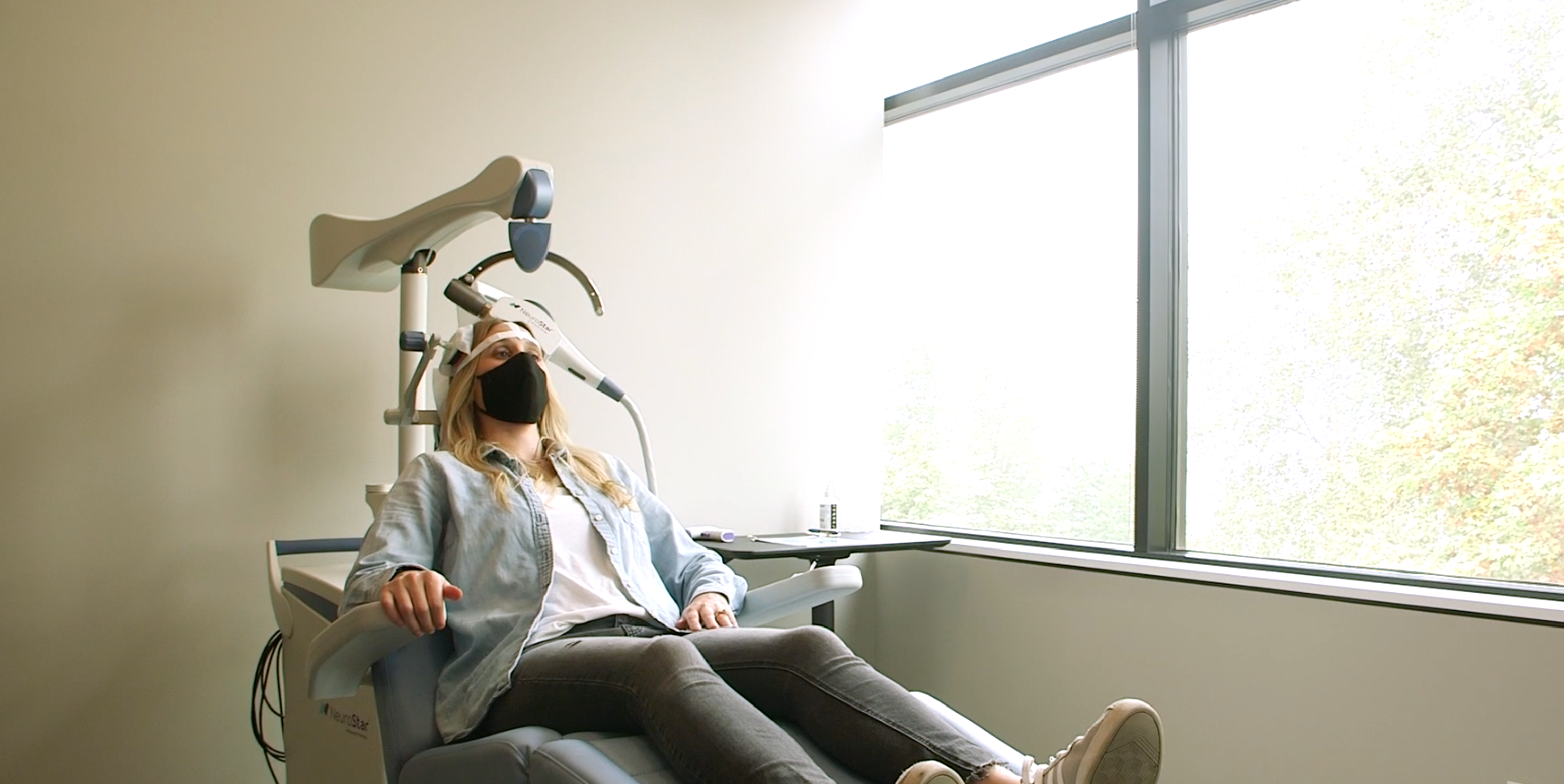People with depression often suffer symptoms for long periods of time before finding a treatment that works. Sometimes, the failure of typical depression treatments can be a result of the drug-resistant nature of the depression itself. Luckily, pharmacology is not the only viable method of treating depression. Transcranial magnetic stimulation (TMS) is a relatively new treatment that has been shown to help people with treatment-resistant depression.
Two well-known TMS procedures are repetitive TMS (rTMS), and deep transcranial magnetic stimulation (deep TMS). Deep TMS therapy was developed after rTMS therapy, and the two procedures are similar. During rTMS therapy, an electromagnetic field is pulsed into the brain with increasing strength. During deep TMS, an electromagnetic field is induced at a continuous strength, using a different type of coil than that used for rTMS. One of the key differences between rTMS therapy and deep TMS therapy is that rTMS repeatedly pulses the electromagnetic field, while deep TMS does not.
WHAT IS TMS?
During transcranial magnetic stimulation (TMS), an electromagnetic coil is placed on the patient’s head. An electric current runs through the coil and generates a magnetic field, as pictured below. The field stimulates brain cells in the region that is commonly responsible for depression. This process changes how the targeted neural networks fire and changes the neural pathways of the depressed patient over time.Clinical results show that the changes in mood are positive.
The short version:
1. A TMS coil is placed on the head.
2. An electric current is run through the coil, generating an electromagnetic field.
3. Areas of the brain associated with mood are stimulated.
4. Over time, mood centers in the brain are affected in such a way as to alleviate symptoms of depression.
During TMS treatment, patients will be directed to remove anything that is magnetically sensitive from their bodies. Patients should alsotell their doctors about any implants they have in their bodies, as some implants are not conducive to TMS treatment. The TMS machine can make some noise, so patients are given earplugs for comfort. The first appointment will be the calibration session, where many settings will be tested (specifically the setting that determines the strength of the magnetic field), and the coil will be adjusted to fit the size and shape of the patient’s head. These settings will be used throughout the rest of treatment. The patient and their doctor will determine the total number of treatments required.
TMS therapy sessions last between 20-40 minutes and are an outpatient procedure, so no hospital stays are required. The procedure also does not require the use of anesthesia, so patients can safely drive home or to work and resume regular activities once treatment is completed. Deep TMS therapy and rTMS therapy are similar, in that an electromagnetic field is used for treatment, but the deep TMS electromagnetic field penetrates deeper than the rTMS electromagnetic field.
There are no systemic side effects of the treatment, but possible side effects include headache, neck pain, and scalp discomfort. TMS is a quick treatment that is easily tolerated. TMS therapy is recommended for depression patients who have had a hard time finding treatments that work. TMS is a less invasive treatment than ECT, a procedure that requires the patient to go under anesthesia while seizures are induced by electric current, through electrodes placed on the head. As of 2008, TMS has been approved by the Food and Drug Administration (FDA) to treat depression symptoms, and there are a number of clinical trials looking at other potential applications as well.
THE DIFFERENCES BETWEEN DEEP TMS AND REPETITIVE TMS
Deep TMS and rTMS have both been shown to be safe methods of treating depression. The significant differences between the two are stimulation depth, coil type, and the length of the session.
Stimulation Depth
Deep transcranial magnetic stimulation is designed to stimulate the reward and motivation pathways of the brain. The reward and motivation pathways are located in what is called the subgenual anterior cingulate cortex. This area is located approximately four centimeters deep in the forehead region. The depth varies by patient, thus the need to calibrate the strength of the electromagnetic field before treatment. Deep TMS is designed to stimulate these areas of the brain.
rTMS therapy penetrates about one and a half centimeters into the brain. The focal area of the electromagnetic field is the dorsolateral prefrontal cortex, which is located near the forehead. This area lies closer to the scalp than the subgenual cingulate cortex targeted during deep TMS.
The dorsolateral prefrontal cortex is responsible for executive and cognitive functions. These functions include abstract reasoning, working memory, intention formation, goal-directed action, attention control, and negative affectivity. One relevant theory on possible causes of depression suggests that it may stem from a defective ability to let go of something unattainable, or disengage with a goal-oriented thought process—all problems associated with negative affectivity. Essentially, this phenomenon is a more severe and abiding version of the temporary sadness that sets in for children when they are told “no”.
Coil Type
Deep TMS therapy uses an H1-coil, which fits inside the front half of a hat-like device to be worn by the patient. The H1-coil applies the magnetic field radially, meaning that the field is applied all around the front of the head. The benefit of having the magnetic field applied radially is that the field can penetrate deeper into the brain without harming the patient.
rTMS therapy uses the figure-8 coil, as shown in the picture above. The figure-8 coil used in rTMS applies the magnetic field vertically, to a narrower area of the head. The repetitive pulses allow for the magnetic field to become increasingly strong without harming the patient.
Length of Session
Deep TMS and rTMS sessions both last about 20 minutes. At Active Path Mental Health, many patients enjoy watching TV or reading during this time.
ACTIVE Path Mental Health OFFERS DEEP TMS TO PATIENTS IN THE PORTLAND AREA
Deep TMS therapy penetrates the brain by about 4 cm, to reach additional nerve centers that cause depression, whereas rTMS therapy penetrates the brain more shallowly, by about 1 cm. Deep TMS therapy uses an H-1 coil to apply the magnetic field radially, while rTMS therapy uses a figure-8 coil to apply the magnetic field vertically. Deep TMS treatments last 20 minutes, while rTMS treatments take about 40 minutes.
Other than the physical look of the devices used to treat patients, and the time that it takes to administer treatment, the real difference lies in the depth of penetration by the electromagnetic field. In a review by Minichino et al., it was found that deep TMS therapy had longer lasting cognitive effects on patients with drug-resistant depression than rTMS therapy.
The goal of any health care provider should be to administer the best treatments with the smallest amount of pain and suffering for the patient. Active Path offers deep TMS, using technology provided by Brainsway, to provide an effective non-medication treatment for severe or treatment-resistant depression.
FAQ’S
What is TMS?
TMS stands for transcranial magnetic stimulation. It’s a treatment that uses magnets to stimulate the prefrontal cortex to promote brain cell activity to decrease depressive symptoms. It’s a drug free therapy with contraindications so limited that patients require no post-treatment monitoring and are able to drive home straight away.
What are the most common side effects of TMS?
The most common side effects of TMS are scalp discomfort and headache.
What is Deep TMS?
Deep TMS stimulates the reward and motivation pathways in the brain. A different coil is required from what is used for Repetitive TMS and treatments last for around 20 minutes.
What is Repetitive TMS?
Repetitive TMS stimulates the brain’s executive and cognitive functions. A different coil is used from what is used for Deep TMS and treatments last around 40 minutes.
All content provided on this blog is for informational purposes only and is not intended to be a substitute for professional medical advice, diagnosis, or treatment. Always seek the advice of your physician or other qualified health provider with any questions you may have regarding a medical condition. If you think you may have a medical emergency, call your doctor or 911 immediately. Reliance on any information provided by the Active Path website is solely at your own risk.




